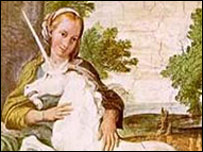|
By David Willey
BBC News, Rome
|

 |
The fresco is a detail from this much larger painting

|
A fresco painting by a Renaissance master which once decorated the bedroom of Pope Alexander VI in the Vatican has gone on show in Rome.
A leading Italian art historian and curator says he has documentary proof that it was once part of a much larger painting depicting the aged Pope kneeling in front of his youthful mistress, Giulia Farnese.
This is an unusual example of "damnatio memoriae" - a Latin phrase meaning "damnation of memory".
It refers to a custom dating back to antiquity - the attempted removal of a famous person from the historical record for reasons of dishonour.
Roman emperors used to order the destruction or removal of portraits or statues of disgraced members of their family.
Debauched lifestyle
Pope Alexander VI, the notorious Borgia Pope from Spain, discredited the Church by his debauched lifestyle.
He fathered seven children, including Lucrezia and Cesare Borgia, by at least two mistresses.

The painting is an exquisite portrait of Jesus
|
Such was Alexander VI's unpopularity that when he died - perhaps by poisoning, perhaps from the plague - in 1503 at the age of 72, the priests of St Peter's Basilica at first refused to accept his body for burial.
Pope Alexander's portrait, commissioned from Pinturicchio to decorate the papal bedchamber inside the Apostolic Palace at the Vatican, was later hacked away from the wall, most likely during the 17th Century, and was believed lost until very recently.
The painting showed Alexander kneeling in front of the Child Jesus and the Virgin Mary, whose face, according to documentary evidence from several contemporary sources, was that of one of his mistresses, a handsome young Roman noblewoman called Giulia Farnese.
The small segment of this much larger original fresco painting now on display is an exquisite portrait of the child Jesus. The child has a halo of pure gold painted around his head.
This extraordinarily fine painting came onto the international art market three years ago and was bought by an Italian industrialist from Perugia.
Mystery hands
There are five hands shown on the painting. Professor Franco Nuccirelli from Perugia, the curator of the exhibition, who rediscovered the painting, told me he believes that two of the hands belong to the missing figure of the Virgin Mary, who clasps the child gently around his waist.
The child has one hand raised in a blessing and holds a golden orb surmounted by a cross in the other.

One of Pope Alexander VI's children was the notorious Lucrezia Borgia
|
The fifth hand, according to Prof Nuccirelli, is that of the missing figure of Pope Alexander himself. His hand gently fondles the child's right foot.
We know exactly what the picture in the Pope's bedroom looked like. It was copied by a 17th-Century artist called Pietro Facchetti while still in situ.
This copy is now in the possession of another Roman noble family. Prof Nucciarelli's proof that this fragment belongs to the lost masterpiece of Pinturicchio looks very convincing.
The famous art historian and scholar Giorgio Vasari, writing in the second edition of his Lives of the Artists in 1568, mentioned that Pinturicchio's painting was "over the door of a room in the Apostolic Palace".
It was, said Vasari, "a portrait of Signora Giulia Farnese with the countenance of Our Lady, and in the same picture the head of Pope Alexander adoring her".
Frustratingly, there is only one surviving portrait of Giulia Farnese, whose brother Alessandro Farnese later became Pope Paul III.
The portrait is in the Museum of the Castel Sant'Angelo in Rome, where it is attributed to the Roman painter Luca Longhi.
It shows a young woman rather wistfully seated in a mountain landscape next to a unicorn - the fabled beast is one of the heraldic emblems of the Farnese family.
 |
 Naturally [the Vatican] are not very happy about publicity of this sort Naturally [the Vatican] are not very happy about publicity of this sort 
|
I asked Prof Nucciarelli what had been the reaction from the Vatican to his discoveries.
"Naturally they are not very happy about publicity of this sort," he said.
"But we have been in Alexander's bedroom, which is one of the clearly identifiable rooms in the Borgia apartment of the Apostolic Palace.
"There is exactly the right space above the door where the painting would have fitted. But so far we have not received permission to examine the present state of the wall which is hidden by a tapestry."
First mistress
Pope Alexander VI's first and best known mistress was called Vanozza dei Cattanei.
She was the mother of Lucrezia and Cesare Borgia and several portraits of her are in existence.

The one surviving portrait of Giulia Farnese shows her with a unicorn
|
You can see her tomb and a portrait bust in a rather dark side chapel inside the church of Santa Maria del Popolo in Rome.
After visiting the exhibition I went back to view her portrait which I had not looked at for some years. Decidedly matronly, I thought.
Vanozza had three husbands in addition to her relationship with Pope Alexander, by whom she bore four children altogether.
The nice thing about living in Rome is that most events here are historically well-documented. You can walk into any church to check the facts.
In Rome you actually touch history every day by simply walking down the street.


~RS~q~RS~~RS~z~RS~23~RS~)